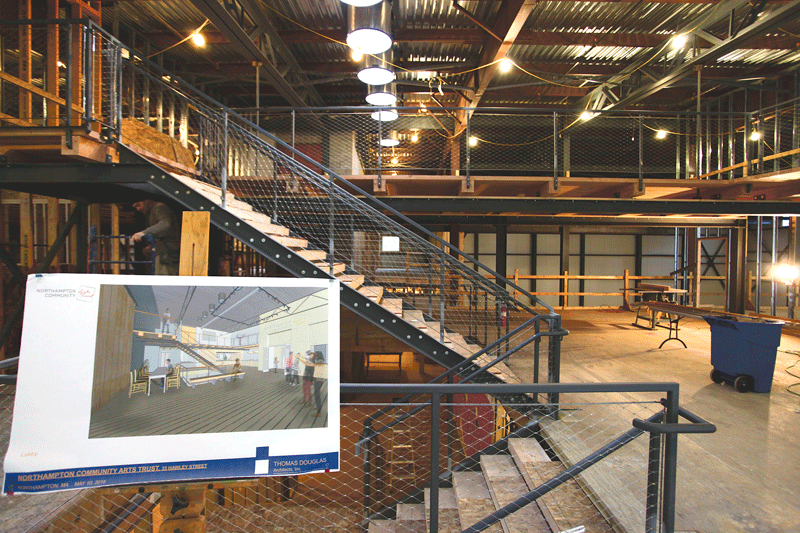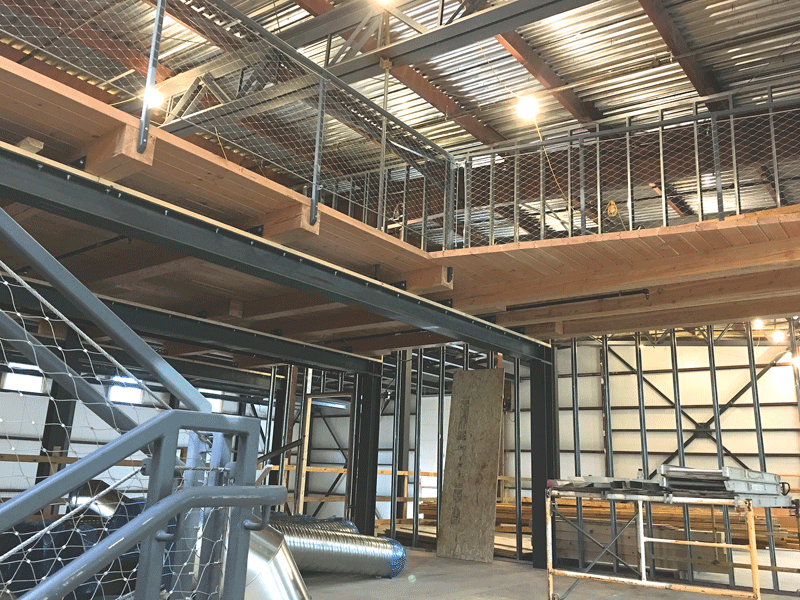Northampton Facility Offers Affordable Space for Creatives
A Dream Home for the Arts
By Kathleen Mellen

An architect’s rendering of the new facility on Hawley Street in Northampton.
Thomas Douglas Architects
It’s been four long years since the Northampton Center for the Arts had a place to call home. But that’s about to change.
In September, the center will become the first tenant of a building at 33 Hawley St. in Northampton, purchased in 2013 by Northampton Community Arts Trust, a nonprofit organization whose mission is to preserve space for use by artists. It was conceived on the principle of a land trust, in which land is purchased with a particular intention, such as preservation.
“The arts trust’s mission is to preserve, in perpetuity, spaces for the use of arts,” said Penny Burke, executive director of the Center for the Arts, who has been involved in the development of the trust since its inception. “We need a multi-purpose, multi-functioning community place for the arts.”
The need for such a space became abundantly clear in 2013, when the nonprofit Center for the Arts lost its home of nearly 30 years at the former D.A. Sullivan School complex in downtown Northampton, after its non-renewable lease expired.
As Burke searched for new space that could accommodate the center’s programming of music, dance, theater, and visual arts — a process that took far longer than she had anticipated — she was forced to mothball much of its equipment and programming, and run the operation out of a small office on Strong Avenue, or, at times, from her home.
After a number of disappointing false starts, Burke said, the center entered into a collaborative search for space with interested city residents and other arts organizations, including Available Potential Enterprises, Ltd. (APE), which, in 2006, had moved out of its 10,000-square-foot home in Thornes Marketplace after the building was sold. APE has since relocated to a much smaller space on Main Street, which doesn’t accommodate many of the performances that had been a major part of its programming.


The spacious interior of the new facility in Northampton provides ample space for artists.
“Our interest is not in occupying the space,” said Gordon Thorne, the founding director of APE, “but we want to have input into programming in the building. We were looking for a way to replicate what we had in Thornes, to replace our performance capacity. This is really completing that goal for us.”
Northampton has long had a reputation as a premier arts town. It is home to scores of visual and performing artists who have been flocking to the city since the mid-’70s, when an economic downturn resulted in storefront vacancies and cheap rent. That was like a siren call to artists, who typically have limited economic resources.
With the resulting influx of creative individuals, by the early 2000s, the arts had become integral to the personality, character, and economic health of the city. Not only has it been dubbed one of the best small arts towns in the country, it has also been named one of the nation’s top 25 arts destinations.

Richard Wagner says artists need affordable space, and the new facility created by Northampton Community Arts provides it.
But all that has come at a price to the artists, says Richard Wagner, president of the Northampton Community Arts Trust’s volunteer board of directors. As the arts have helped propel the city’s renewed economic vibrancy, vacancies have been filled, and prices for space have exploded, leaving many of the artists to discover that they have unwittingly helped price themselves right out of their artistic homes.
“The end state of any creative economy is going to be where creativity has been pressed out of the market,” Wagner said. “Artists need space, and if you want to keep artists, if you want to keep the creativity, you’ve got to lock in affordability, or they go somewhere else. That’s what’s happening in Northampton.”
The Northampton Community Arts Trust aims to stem that tide.
Planning a Reboot
To be sure, Burke’s organization has not been dormant during the past four years, but programming has been minimal; she has continued to present the center’s annual chalk art, ice art, and en plein air painting festivals, as well as hosting Northampton’s First Night Celebration — a venture the center will turn over to the Northampton Arts Council this year after running it for 32 years.
Now, Burke says, she’s excited to have a home where she can reinstate the plethora of arts and community activities that have been the center’s hallmark. “It’s been a huge hole,” she noted.
The Center for the Arts will serve as an operational and managerial tenant of the Hawley Street building, and will facilitate much of the core programming. With that slated to begin right after Labor Day, Burke explained, she’s hustling to get her ducks in a row, reaching out to the center’s resident companies, including the Lisa Leizman Dance Co. and the Happy Valley Guitar Orchestra, and booking space for classes, rehearsals, and, eventually, performances. Other organizations are expected to follow the center into the space shortly, including Northampton Community TV, which will have an education and media center there.
We wanted to create a building with minimal operating expenses, where artists can actually afford to work, and that meant not borrowing money. I had the capital, so I paid it.”
The center’s move to Hawley Street is one step in a long journey that began in earnest with the $1.5 million purchase in 2013 of the former site of Northampton Lumber, a 25,000-square-foot building on 1.5 acres of land. Money for the purchase was initially raised through private donations and a short-term loan, but was ultimately paid in full by Thorne, who reimbursed the trust for the cost of the building.
“We wanted to create a building with minimal operating expenses, where artists can actually afford to work, and that meant not borrowing money,” Thorne said. “I had the capital, so I paid it.”
While some events were held in the building for several months after it was purchased, all that was put on hold in 2015, when construction began to build the trust’s dream home for the arts.
The $6.5 million project (which includes the purchase of the building) is being done in three phases, under the guidance of Thomas Douglas Architects. Phase one, with a cost of just over $1.86 million, is nearly complete, and has included an overall renovation of the building and indoor framing.
“We had to do basic development work because of the shape the building was in,” Wagner told BusinessWest. “We framed out the spaces, added an elevator … we took a beat-up box of a building and gave it a new skin.”
That work also included the addition of energy-efficient features, such as a highly insulated shell and roof, as well as a solar array, donated by Thorne, which should provide the building with essentially free electricity. “Our HVAC costs should be minimal,” Wagner said.
Phase 2 will be a complete build-out of the building’s interior, including a lobby and mezzanine, an 800-square-foot exhibit gallery, and space for performances, events, and workshops, as well as site work and landscaping. With an estimated cost of $2.5 million, that phase will have to wait while the trust secures further funding, but Burke and Wagner say they hope it will be completed by the end of 2018.
In the meantime, in order to accommodate an initial, limited public use of the building, the city awarded the trust a limited-occupancy permit to utilize space on the lower level of the two-story building, including a 1,200 square-foot multi-purpose studio for rehearsals, classes, and small performances, events, and meetings.
Burke has already booked some art classes and is working with local choreographer Kelly Silliman to create a dance program that will utilize a 900-square-foot dedicated dance studio that will be available for use on the upper level.
There will also be a series of outdoor events this summer, dubbed “Outside the Box,” that will feature film, music, and poetry presentations.
Looking Ahead
The current plan for phase 3 will be the creation of a 3,800-square-foot black-box theater on the lower level, capable of seating more than 200 patrons, as well as ancillary space, such as dressing rooms and a green room. That will be undertaken when the rest of the building is complete, Burke said, but only after members of the local theater community, including APE, have an opportunity to weigh in on its design.
We want to create a separate body of people who will take on the design and management of that space. We need to take into consideration not only technical aspects of theater, but to ask where that whole realm of creative work will be in the future.”
It’s a concept that still needs a lot of thought before a budget and timeline can be established, Thorne told BusinessWest.
“We want to create a separate body of people who will take on the design and management of that space,” he said. “We need to take into consideration not only technical aspects of theater, but to ask where that whole realm of creative work will be in the future.”
To date, the trust has raised roughly $4.38 million through gifts from individual donors, as well as government and institutional grants, including $50,000 from the Community Foundation of Western Massachusetts, $35,000 from the Beveridge Family Foundation, $25,000 from C&S Wholesale Grocers, $180,000 from the state Executive Office for Administration and Finance, and $140,000 and $300,000 in separate grants from the Massachusetts Cultural Council. The Center for the Arts contributed $400,000 — money that had been saved over the years from First Night revenue specifically to pay for a new home.
While what Wagner calls the “quiet” phase of the capital campaign continues, focusing on individual donors and other grant opportunities, he said a public capital campaign will be launched at a future date.
As those plans move ahead, Thorne said, it will be incumbent upon the trust to articulate its plans and its mission to the public. “We need to educate the community about what this is, our bigger mission.”
To that end, Wagner hopes the programming that will take place under the partial occupancy allowance will generate public awareness, and interest in supporting the space and the trust.
“One of the reasons we’re doing this is to get the building back into use,” he said. “We want to open it up to the public, so they can feel and taste the possibilities.”




